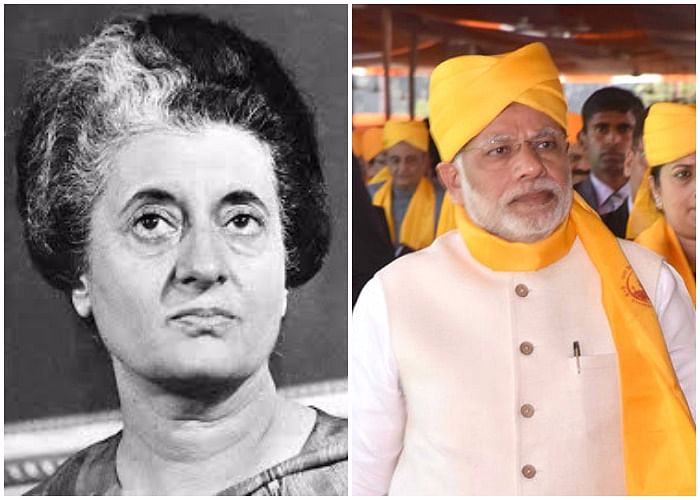Even the most ardent supporters of Prime Minister Narendra Modi say that there are many similarities between him and former PM Indira Gandhi. Her authoritarian style of leadership, the complete loyalty she demanded from her party members and cabinet, and the strong role of the state that she envisioned in her policies are just some commonalities. The cult-like following that she enjoyed — illustrated by the slogan ‘Indira is India, and India is Indira’— is mirrored in the sentiment of ‘ghar ghar Modi’ and Modi bhakti that is present across many parts of the country today.
On her 100th birthday anniversary, we ask experts: Is Modi the new Indira?
The comparison between Indira Gandhi and Narendra Modi does not seem to be valid. To begin with, Indira Gandhi’s economic policies were mostly left-of-centre, whether it was curbs on monopolies, nationalisation of banks, abolition of privy purses, or promotion of public sector industries. She also initiated many pro-poor measures, such as abolition of debt bondage, land and house-sites for landless labour, and low-cost loans for livelihood generation. Even during the Green Revolution, she tried to protect the rights of small and marginal farmers by providing cheap inputs and credit.
On the contrary, the Modi government’s economic policies are right-of-centre or pro-business; they have nothing to offer to the poor and the marginalised. In fact, demonetisation and the Goods and Services Tax have hit the poor very hard. There were two million job losses, mainly in small and medium industries, which provide employment to the unorganised labour and were badly hit by these policies.
When it came to maintaining communal harmony, Mrs Gandhi had a different approach. Even during the run up to the 1971 war which led to the dismemberment of Pakistan and the creation of Bangladesh, she never framed the conflict in communal terms by emphasising the brutal ‘Islamic’ character of Pakistan and encouraging a jingoistic chauvinistic ‘nationalism’ in India.
Here are other sharp perspectives on the comparison between Indira Gandhi and Narendra Modi:
Zoya Hasan, Professor Emerita, JNU
Sanjay Nirupam, president, Mumbai Congress Committee
Sagarika Ghose, journalist and author of ‘Indira, India’s Most Powerful Prime Minister’
Sangit K. Ragi, professor of political science, Delhi University
Today, so-called surgical strikes against Pakistan are used to whip up a communal frenzy in the garb of nationalism, which encourages vigilante attacks on minorities, and much else, with the Prime Minister usually maintaining a strategic silence.
It is only during Emergency that freedom of speech was suppressed and curbs imposed on the media. Under Modi, we are facing what Arun Shourie called “a decentralised emergency”. There is no formal declaration of emergency, but freedom of expression and other rights are being curtailed now.
Even their leadership styles are different. Mrs Gandhi maintained a direct rapport with people and always emphasised on the welfare of the poor and the marginalised. If one looks at her election strategy in 1971, her slogan was ‘Garibi Hatao’; her main focus was to remove poverty. She implemented many concrete policies to give effect to her promises. Her comeback trail after she lost power in 1977 began with her famous visit to Belchi, where Dalits had been massacred by upper castes. The poor and oppressed looked upon her as Indira amma or Mother Indira, and when she died, cooking fires were not lit for a couple of days in many poor homes in villages to mourn her death.
However, Modi’s speeches are full of rhetoric. He talks about ‘achhe din’ (good days); fighting the black money menace and corruption, but these are not accompanied by concrete action. The government has also come up with a series of unrealistic promises, including doubling farmers’ income and creating new jobs. But in reality, jobs have been lost, not created. The only action we saw, demonetisation and GST, failed miserably.
In foreign policy, the contrast could not be greater. Indira Gandhi firmly maintained the independence of India’s relations with foreign powers and promoted the Non-Aligned Movement as a bulwark against big power hegemony. She stood up to the US even when it tried to frighten her with the Seventh Fleet in the Bay of Bengal during the Bangladesh crisis.
We now seem to be leaning far too much towards the American view of the world, even when that view is embodied in Donald Trump, whose reliability is seriously doubted by increasing numbers of Americans themselves, as well as by their European allies.
Mridula Mukherjee is the former director of Nehru Memorial Museum and Library, and former professor of history at JNU
TalkPoint compiled by Nikhil Rampal
